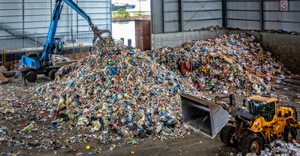Pulling the Rug Out
Diverting billions of pounds of discarded carpet from landfills.
December 1, 2010
Jeremy Stroop
Each year, billions of pounds of old carpet are removed from residential and commercial buildings and sent to landfills across the United States. This disposal of carpet contributes to the loss of landfill space, as well as the loss of valuable natural resources. Since carpet is produced from petroleum-based products, one gallon of oil is lost for every three square yards that are disposed in landfills. The Carpet America Recovery Effort (CARE), a non-profit environmental organization headquartered in Dalton, Ga., works with its partners across the country to develop solutions to reclaim this material for reuse.
In order to understand carpet recycling and how it works, it is important for consumers to view carpet as a synthetic material made from oil. Once consumers make the leap from looking at carpet as a beautiful floor covering to seeing it as a product that begins when plastic pellets are heated and stretched to make carpet fiber, they begin to appreciate how carpet is suitable for recycling.
One challenge is to educate consumers about the many recycling options for their used carpet, from industrial plastics to consumer products. “Every day, innovative companies are transforming post-consumer carpet into usable products, which means that we are using fewer natural resources and eliminating lots of product going to the landfill,” explains Georgina Sikorski, executive director of CARE.
Since 2002, the carpet reclamation industry has expanded from just a handful of participants to a vast network of collectors, processors and manufacturers. Eight years ago, there were only five carpet reclamation sites. Today there are 79, representing an almost 1,500 percent increase in the number of sites available to take back old carpet for recycling and reuse. “Given the fact carpet is bulky and heavy, it is essential the majority of collection, sorting and processing is done at the local reclamation facilities,” says Sikorski. “Regional processing ensures only valuable materials are shipped to processing and manufacturing facilities, thus reducing the recycling cost and environmental impacts.”
Similar to other recycled plastic materials, carpet is purified during the recycling process to remove any contaminants. And like plastic containers, it is important to distinguish the type of plastics in the carpet prior to recycling. In the United States, the majority of carpets are made from Nylon 6, Nylon 6.6, Polypropylene (PP) and Polyethylene Terephthalate (PET). Plastic identification is necessary because specific plastics lend themselves to particular recycling options due to their various chemical properties. For example, Nylon 6.6 is well suited for under-the-hood automotive industry applications because of its ability to maintain integrity under extreme heat. Meanwhile, because of its distinct properties, Nylon 6 is often processed into parts for inside the vehicle.
CARE’s 2010 Annual Report points out that Nylon 6 and Nylon 6.6 represent 80 percent of all carpet diverted from landfills in 2009. Two forces are driving nylon’s reclamation percentages: 1) the availability of end-markets for recycled nylon fiber and 2) the predominant market share of nylon carpet sold in the United States. In 2009, CARE reported that 311 million pounds of post-consumer carpet were diverted from landfills. Of that amount, 246 million pounds were diverted as a direct result of reuse and recycling.
Because economic barriers and variations in market demand mean that not all carpet fiber types can be recycled, different energy recovery uses have been identified and employed to further divert carpet that otherwise has no other available reuse and recycling options. Reclamation facilities work under the common philosophy of “highest and best use” when deciding on the management methods that will most efficiently divert carpet materials. Oftentimes, waste carpet is processed so that all its valuable materials are separated and the remnants are used in one of several energy recovery solutions. Carpet byproducts that remain after the material harvesting process are known as Carpet as an Alternative Fuel (CAAF). It is important to note that CAAF is different from the traditional waste-to-energy (WTE). Through a careful separation and harvesting process, CAAF is more beneficial to the environment than other WTE and incineration options. CAAF strives to employ the highest and best use for the recovery and reuse of post-consumer carpet. An example of this practice is when the valuable carpet facefibers are separated from a carpet and the remaining less valuable materials, such as the backing and adhesives, are used for energy.
The carpet industry, governments, environmental organizations and consumers continue to seek out additional beneficial uses for post-consumer carpet. As momentum builds and technological and market advancements allow for increased recovery and reuse of this valuable resource, the carpet recycling industry will continue to grow. Because only 10 percent of the available post-consumer carpet material is currently being collected and used, opportunities abound in the carpet recycling industry. Companies interested in diversifying their processing and material inputs may benefit from exploring options within this budding industry.
Jeremy Stroop is operations manager for the Carpet America Recovery Effort (CARE). CARE was formed as a result of the Memorandum of Understanding for Carpet Stewardship, a national agreement signed by members of the carpet industry, representatives of government agencies at the federal, state and local levels and non-governmental organizations. CARE works to develop market-based solutions for recovering value from discarded carpet in order to achieve the organization’s ultimate goal of a 40 percent diversion rate of post consumer carpet from the nation’s landfills. For more information or to learn more about how to recycle used carpet, visit www.carpetrecovery.org.
Related Stories
You May Also Like


